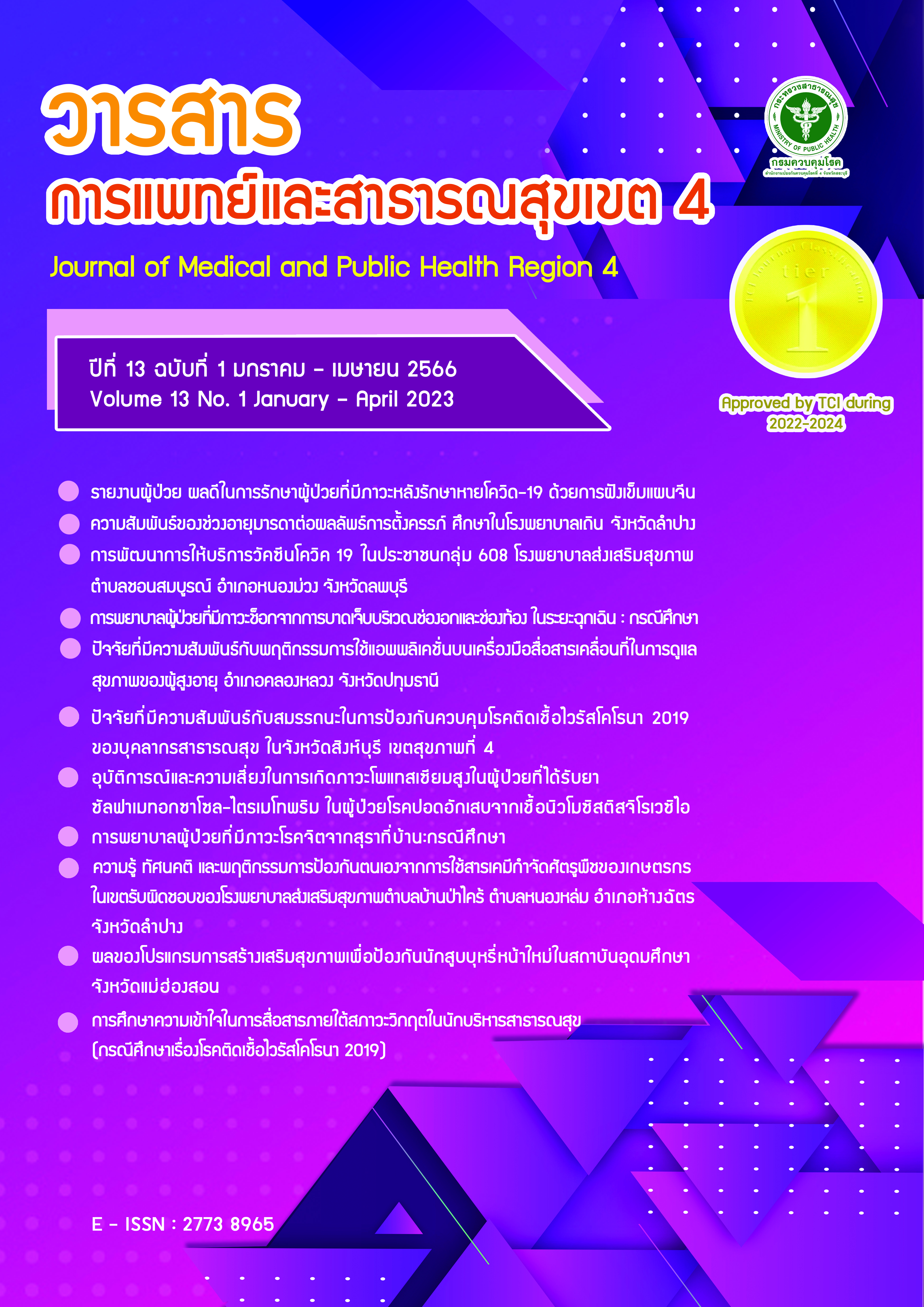Nursing care of thoracoabdominal injury patient with shock during the emergency phase: Case study
Main Article Content
Abstract
Changes in the circulatory system lead to shock, Resulting in the circulation especially the oxygen within the body decreases, causing cells and issues to be unable to use oxygen for energy metabolism. Additionally, it influences many organ malfunction and is a cause of mortality. Currently, there are standards for the care of patients for the care of patients with traumatic injuries (Advanced Trauma Life Support) of The American Association of Surgeons Standard. Including, nursing practice guidelines of caring for trauma patients with shock together with the use of empirical evidence. Therefore, it is crucial to promote accurate and quick treatment within the "Golden hour period" of care. Emergency nurses are important personnel in caring for patients. This is done to avoid major complications that could become the cause of death.
Article Details

This work is licensed under a Creative Commons Attribution-NonCommercial-NoDerivatives 4.0 International License.
References
World Health Organization. Injuries and violence [Internet]. Geneva: World Health Organization; 2021 [cited 2022 Sep 27]. Available from: https://www.who.int/news-room/fact-sheets/detail/injuries-and-violence
Doungthipsirikul S, Sirisamutr T, Wachiradilok P. Report on the situation of emergency medical services and the development of operating quality for severely injured patients (Major trauma) [Internet]. Nonthaburi: National Institute for Emergency Medicine; 2022. [cited 2022 Sep 27]. Available from: https://www.niems.go.th/1/uploadattachfile/2022/ebook/415820_20220624104504.pdf (in Thai)
Kanchanitanont C, Vipavakarn S, Prombutr R. The Development of Nursing Care Model for Severe Multiple Injury in Krabi Hospital. Journal of The Royal Thai Army Nurses [Internet]. 2019 [cited 2022 Sep 18];20(1):340-49. Available from: https://he01.tci-thaijo.org/index.php/JRTAN/article/view/185135/130230 (in Thai)
Kislitsina ON, Rich JD, Wilcox JE, Pham DT, Churyla A, Vorovich EB, et al. Shock - Classification and Pathophysiological Principles of Therapeutics. Current cardiology reviews [Internet]. 2019 [cited 2022 Sep 10];15(2):102-13. Available from: https://www.ncbi.nlm.nih.gov/pmc/articles/PMC6520577/pdf/CCR-15-102.pdf
American College of Surgeons. Advance Trauma Life Support: the tenth edition. Chicago: American College of Surgeons; 2018.
Norasan S. Trauma nursing. Bankok: Idea Instant Printing; 2021. (in Thai)
Odom SR, Howell MD, Gupta A, Silva G, Cook CH, Talmor D. Extremes of shock index predicts death in trauma patients. Journal of emergencies trauma and shock [Internet]. 2016 [cited 2022 Sep 18];9(3):103-6. Available from: https://www.ncbi.nlm.nih.gov/pmc/articles/PMC4960776/
Tapar H, Karaman S, Dogru S, Karaman T, Sahin A, Tapar GG, et al. The effect of patient positions on perfusion index. BMC Anesthesiology [Internet]. 2018 [cited 2022 Sep 18];18(1):111-15. Available from: https://www.ncbi.nlm.nih.gov/pmc/articles/PMC6097320/pdf/12871_2018_Article_571.pdf
Yoosook S, Suwanmontri P, Charoenrat P, Ninsonthi N. Developing a Model of Care for the Multiple Trauma Hypovolemic Shock Patients in Sawanpracharak Hospital. Journal of the Department of Medical Services [Internet]. 2017 [cited 2022 Sep 10];42(6):96-101. Available from: https://he02.tci-thaijo.org/index.php/JDMS/article/view/248671/169122 (in Thai)
Panhom N, Chanruangvanich W, Chayaput P, Thosingh O. Comparative Study of Factors Related to Traumatic Shock Between Adult and Older Adult Injured Patients. Journal of Thailand Nursing and Midwifery Council [Internet]. 2565 [cited 2022 Sep 9];37(2):128-43. Available from: https://he02.tci-thaijo.org/index.php/TJONC/article/view/256887/176510. (in Thai)
Department of medical services. MOPH ED. Triage. Bankok: Department of medical services; 2018. (in Thai)
National Institute for Emergency Medicine. Interfacility Patient Transfer. Bankok: Ultimat printing; 2014. (in Thai)


